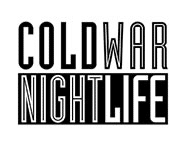What do you do at a night cafe? You sit. And what do you like most? Sitting by the seaside, if you grew up with folksy English songs. Martin (the intense knob-twiddling one) and Anais (the one with the lovely voice), in their Vile Electrodes incarnation, have been playing with their remix title, as well as OMD’s sounds on this single. All good fun with an insider’s wink.
coldwarnightlife
When Space came out with their synth-heavy disco hit, Magic Fly, it inspired some Soviet musicians to make space-disco of their own. Zodiac (or Zodiaks) was a band formed in the music academy of the Latvian Soviet Socialist Republic. Their first album, Disco Alliance, sold millions of copies behind the Iron Curtain in the 1980s on the Melodia label. Strikingly, the album cover was mainly in English, which was unheard of for a Soviet act and only made it more desirable at the time. This eponymous track comes with video footage from a Soviet science fiction film, which was added by the uploader to Youtube. Both sound and vision are gems.
If you don’t recognise her from the Nokia ad or as the writer behind Norway’s popular Eurovision entry, then you’re falling behind. Karin Park has emerged from the Scandi pop scene as an international star-in-the-making. With her brother, Daniel, looking after the drums and triggering other instruments in real time, Park is in good form in this video, shot at an intimate gig in Stockholm.
Topgun were a strong warm-up act at S.P.O.C.K’s 25th anniversary show. Bathed in strong red light, Sem Hilti Johansson took vocal duty for a set of sophisticated synth pop, showcasing the sound he has been developing since the late 90s. This track fuses classic analogue electronics with a very radio-friendly vocal line.
One of the defining features of Deutsch Amerikanische Freundschaft’s proto-EBM was the unlikely but effective combination of sex and sequencers. When England’s Nitzer Ebb inherited the DAF style, they dialled down the former in favour of the latter, developing a more aggressive sound. In this cover of a classic Nitzer Ebb track, Diskodiktator restore the balance, adding some primal sweat to the proceedings.
Now that Alison Moyet has rediscovered electronic music, it is worth recalling an interim step between Yazoo and her latest solo album. In 2009, Moyet appeared on a single by My Robert Friend, the New York project of one Howard Robot. The track was a reminder of the affinity between Moyet’s vocals and synthetic sounds – in this case, a combination of waveforms that seem to have been lifted from Depeche Mode’s 1982 masterpiece, A Broken Frame. Perfect to get over the mid-week hump.
Ahead of their upcoming Helsingborg gig on 27 July, CWNL cover stars Train to Spain spoke with Radio Active 103.9 FM in Sweden about the band’s background and plans. The interview is in Swedish only, but features a great selection of out-takes from the band’s developing list of hot tracks.
The A.M. Experiment has been bubbling under the radar for some time, but with the release of Black Rain the project is definitely above-the-fold material. This track is part of a new EP from Austrian Markus Liebhart, and it combines retro acid lines with looped percussion that will have your dance shoes aching for your feet.
Mitsou Gélinas is better known for her first single, Bye Bye Mon Cowboy, but by 1990’s Terre des Hommes album the chanteuse from Quebec was attracting pop songwriting support from none other than Ivan from Men Without Hits. Ivan doesn’t appear in this video, but his influence (and vocal contribution) is unmistakeable. This song is a slice of happiness for a rainy day.
This magazine is named for a Rational Youth album, so it isn’t a reach to find this classic in the archives. In Your Eyes didn’t make it onto the first album, so was recorded in a more guitar-oriented version for the post-Vorn major label release that followed. That version was used in the film Crazy Moon. This version was used on Musi-Video, the classic Montreal TV showcase for local talent. Both are brilliant, but this version has the classic touch.
